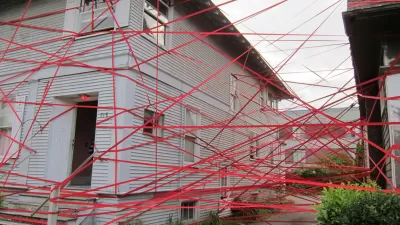Urbanists must adopt less bureaucratic approaches so that the next generation can build and grow the economy, Andres Duany says. Hence the proliferation of “lean” codes that emphasize only the essentials of shaping community.
Robert Steuteville explores Andres Duany's "stirring plenary session" at the recent Congress for the New Urbanism in Salt Lake City, Duany Plater-Zyberk & Company's recent work in High Point, North Carolina, and other efforts to adapt the SmartCode.
"Three crises of the new century -- the dearth of capital, the slow-motion calamity of climate change, and the ongoing high costs of petroleum -- have changed the prospects of the next generation of urbanists, [Andres Duany] says."
"Town centers will be built successionally, starting with single-story buildings. High-tech environmentalism will fail and low-tech 'original green' sustainability will flourish. Flex buildings designed to change uses and interim buildings that fill needs while waiting for a permanent replacements will be key, he says. Tactical Urbanism, the next generation’s mantra, is all about retrofitting streets and public spaces with grass roots energy and limited resources."
"Finally, Duany touted 'code pink,' or a highly simplified new urban code. Other code experts are developing similar 'pocket codes,' or 'minicodes' that boil form-based standards down to bare essentials that are easy to understand and facilitate quicker, cheaper, more pain-free approvals."
FULL STORY: Walkability, but hold the red tape

Planetizen Federal Action Tracker
A weekly monitor of how Trump’s orders and actions are impacting planners and planning in America.

Map: Where Senate Republicans Want to Sell Your Public Lands
For public land advocates, the Senate Republicans’ proposal to sell millions of acres of public land in the West is “the biggest fight of their careers.”

Restaurant Patios Were a Pandemic Win — Why Were They so Hard to Keep?
Social distancing requirements and changes in travel patterns prompted cities to pilot new uses for street and sidewalk space. Then it got complicated.

Platform Pilsner: Vancouver Transit Agency Releases... a Beer?
TransLink will receive a portion of every sale of the four-pack.

Toronto Weighs Cheaper Transit, Parking Hikes for Major Events
Special event rates would take effect during large festivals, sports games and concerts to ‘discourage driving, manage congestion and free up space for transit.”

Berlin to Consider Car-Free Zone Larger Than Manhattan
The area bound by the 22-mile Ringbahn would still allow 12 uses of a private automobile per year per person, and several other exemptions.
Urban Design for Planners 1: Software Tools
This six-course series explores essential urban design concepts using open source software and equips planners with the tools they need to participate fully in the urban design process.
Planning for Universal Design
Learn the tools for implementing Universal Design in planning regulations.
Heyer Gruel & Associates PA
JM Goldson LLC
Custer County Colorado
City of Camden Redevelopment Agency
City of Astoria
Transportation Research & Education Center (TREC) at Portland State University
Camden Redevelopment Agency
City of Claremont
Municipality of Princeton (NJ)




























